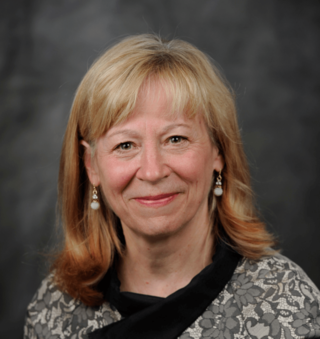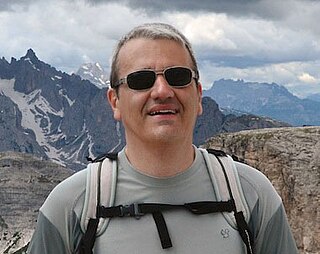Related Research Articles

Physical chemistry is the study of macroscopic and microscopic phenomena in chemical systems in terms of the principles, practices, and concepts of physics such as motion, energy, force, time, thermodynamics, quantum chemistry, statistical mechanics, analytical dynamics and chemical equilibria.

Self-assembled monolayers (SAM) of organic molecules are molecular assemblies formed spontaneously on surfaces by adsorption and are organized into more or less large ordered domains. In some cases molecules that form the monolayer do not interact strongly with the substrate. This is the case for instance of the two-dimensional supramolecular networks of e.g. perylenetetracarboxylic dianhydride (PTCDA) on gold or of e.g. porphyrins on highly oriented pyrolitic graphite (HOPG). In other cases the molecules possess a head group that has a strong affinity to the substrate and anchors the molecule to it. Such a SAM consisting of a head group, tail and functional end group is depicted in Figure 1. Common head groups include thiols, silanes, phosphonates, etc.
The Electrochemical Society is a learned society based in the United States that supports scientific inquiry in the field of electrochemistry and solid-state science and related technology. The Society membership comprises more than 8,000 scientists and engineers in over 85 countries at all degree levels and in all fields of electrochemistry, solid state science and related technologies. Additional support is provided by institutional members including corporations and laboratories.
Johannes G. Vos, also known as Han Vos is Emeritus Professor of Inorganic Chemistry at Dublin City University in Ireland.
Robert J. Forster is a professor of Physical Chemistry at Dublin City University. He is a member of the Royal Irish Academy.

Vincenzo Balzani is an Italian chemist, now emeritus professor at the University of Bologna.
The following outline is provided as an overview of and topical guide to biophysics:
Judith Herzfeld is Professor Emerita at Brandeis University. Known for her work in statistical thermodynamics, solid state NMR and chemical education, she is a fellow of the American Physical Society, the American Association for the Advancement of Science, and the Massachusetts Academy of Sciences. She is the author or coauthor of more than 180 scientific papers and a book.

The term macromolecular assembly (MA) refers to massive chemical structures such as viruses and non-biologic nanoparticles, cellular organelles and membranes and ribosomes, etc. that are complex mixtures of polypeptide, polynucleotide, polysaccharide or other polymeric macromolecules. They are generally of more than one of these types, and the mixtures are defined spatially, and with regard to their underlying chemical composition and structure. Macromolecules are found in living and nonliving things, and are composed of many hundreds or thousands of atoms held together by covalent bonds; they are often characterized by repeating units. Assemblies of these can likewise be biologic or non-biologic, though the MA term is more commonly applied in biology, and the term supramolecular assembly is more often applied in non-biologic contexts. MAs of macromolecules are held in their defined forms by non-covalent intermolecular interactions, and can be in either non-repeating structures, or in repeating linear, circular, spiral, or other patterns. The process by which MAs are formed has been termed molecular self-assembly, a term especially applied in non-biologic contexts. A wide variety of physical/biophysical, chemical/biochemical, and computational methods exist for the study of MA; given the scale of MAs, efforts to elaborate their composition and structure and discern mechanisms underlying their functions are at the forefront of modern structure science.

Geraldine Lee Richmond is an American chemist and physical chemist who is serving as the Under Secretary of Energy for Science in the US Department of Energy. Richmond was confirmed to her DOE role by the United States Senate on November 5, 2021. Richmond is the Presidential Chair in Science and Professor of Chemistry at the University of Oregon (UO). She conducts fundamental research to understand the chemistry and physics of complex surfaces and interfaces. These understandings are most relevant to energy production, atmospheric chemistry and remediation of the environment. Throughout her career she has worked to increase the number and success of women scientists in the U.S. and in many developing countries in Africa, Asia and South America. Richmond has served as president of the American Association for the Advancement of Science, and she received the 2013 National Medal of Science.

Nicola Armaroli is an Italian chemist, research director at the Italian National Research Council (CNR), director of the scientific magazine Sapere and member of the Italian National Academy of Sciences.

Andrzej Wieckowski was an Emeritus Professor of Chemistry at the University of Illinois at Urbana–Champaign and the North American Editor of Electrochimica Acta. He is known for his spectroscopic investigations of electrocatalysis in fuel cells and co-inventing of the direct formic acid fuel cell (DFAFC). He authored more than 300 publications, has been cited over 13,000 times and has an h-index 60. He was appointed fellow of the Electrochemical Society in 2007 and fellow of the International Society of Electrochemistry in 2009. He was awarded the US Department of Energy Prize for outstanding Scientific Accomplishment in Materials Chemistry in 1992, the ISE Jacques Tacussel Prize in 1998, the ECS David. C. Graham Award in 2003, and the ISE Gold Medal in 2007.
Heather Cecile Allen is a research chemist, who leads the Allen Group at Ohio State University. Allen's research focuses on interfacial phenomena, particularly those involving water and air. Her work has broad application ranging from medicine to climate change. She also develops nonlinear optical spectroscopy and microscopy instruments for the examination of interfacial surfaces.
Maria-Elisabeth Michel-Beyerle is a German chemist. From 1974 to 2000, she was a professor of Physical Chemistry at the Technical University of Munich. Among other awards, she has received the 2000 Bavarian Order of Merit, the highest service order bestowed by the Free State of Bavaria, for her work on photosynthesis.
Yang Shao-Horn is a Chinese American scholar, Professor of Mechanical Engineering and Materials Science and Engineering and a member of Research Laboratory of Electronics at the Massachusetts Institute of Technology. She is known for research on understanding and controlling of processes for storing electrons in chemical bonds towards zero-carbon energy and chemicals.

William Michael Gelbart is Distinguished Professor of Chemistry and Biochemistry at the University of California, Los Angeles, and a member of the California NanoSystems Institute and the UCLA Molecular Biology Institute. He obtained his Bachelor of Science degree from Harvard University in 1967, his Master's (1968) and PhD (1970) degrees from the University of Chicago, and did postdoctoral work at the University of Paris (1971) and the University of California, Berkeley (1972). After 30 years of research in theoretical physical chemistry, contributing notably to the fields of gas-phase photophysics, optical properties of simple liquids, and the statistical physics of complex fluids, he started a biophysics laboratory with Charles Knobler in 2002 to investigate the physical aspects of viral infectivity.
Rachel Claire Evans is a Welsh chemist based at the University of Cambridge and a fellow of Jesus College, Cambridge. She works on photoactive polymer-hybrid materials for solar devices, including organic photovoltaics and stimuli-responsive membranes.
Viola Ingrid Birss is a Professor of Chemistry at the University of Calgary. She works on electrochemistry and the development of nanomaterials for sustainable energy and sensing applications. She has demonstrated a metal oxide perovskite that can be used as the air and fuel electrode in solid oxide fuel cells, as well as creating nanoporous carbon scaffolds to be used in batteries and capacitors.
Aoife Gowen is currently a professor in the University College Dublin (UCD) School of Biosystems and Food Engineering. Her area of research covers topics such as applications of hyperspectral imaging and chemometrics to biological systems.
Héctor Daniel Abruña is a Puerto Rican physical chemist whose work focuses on electrochemistry, molecular electronics, fuel cells, batteries, and electrocatalysis. Abruña is director of the Energy Materials Center and Emile M. Chamot professor for chemistry at Cornell University. He became a Fellow of the American Association for the Advancement of Science in 2006, a Member of the American Academy of Arts and Sciences in 2007, and a Member of the National Academy of Sciences in 2018. Abruña conducts research into battery and fuel cell systems using electrochemical techniques and X-ray microscopy and spectroscopy methods.
References
- 1 2 "Tia Keyes | Staff Profile | DCU". www.dcu.ie. 29 January 2015. Retrieved 13 June 2020.
- ↑ "DCU Covid 19 Research | DCU". www.dcu.ie. 28 May 2020. Retrieved 13 June 2020.
- ↑ silicon (14 November 2016). "20 incredible women leading the way to scientific advancement". Silicon Republic. Retrieved 13 June 2020.
- ↑ Dublin City University, Office of the Vice-President For Research Staff Profiles(Accessed Nov 2010)
- ↑ Web of Science reports 100 peer-reviewed scientific papers in journals such as the Journal of the American Chemical Society, Langmuir, Journal of Raman Spectroscopy, Physical Chemistry Chemical Physics, Journal of Physical Chemistry and Inorganic Chemistry and that these works have been cited more than 1000 times and that she has a h-index of 18.(Accessed May 2011)
- ↑ Biophotonics World (Accessed Nov 2010)
- ↑ Royal College of Surgeons of Ireland, Marie Curie Translational Research Fellowships(Accessed Nov 2010)
- ↑ Book Review by Rajendra Rathore Marquette University, J. Am. Chem. Soc., 2003, 125 (44), p 13620